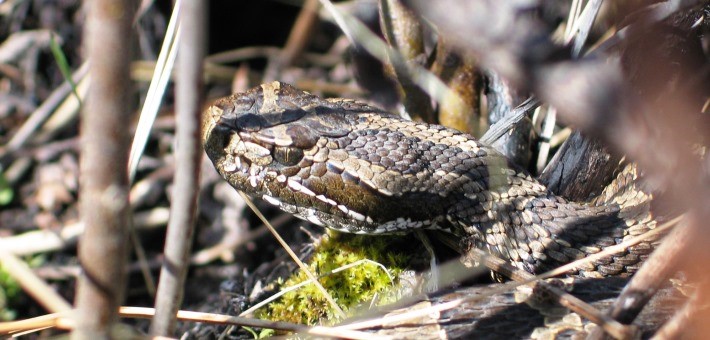
Eastern Massasauga Rattlesnake. Photo courtesy of Dan Kennedy/Michigan Department of Natural Resources.
Effective October 21, 2016, the U.S. Fish and Wildlife Service (USFWS) listed the Eastern Massasauga Rattlesnake (Sistrurus catenatus) as a threatened, protected species under the Endangered Species Act.
The new rule comes as no surprise, as the Eastern Massasauga has been considered for listing under the Endangered Species Act since 1999. The final ruling came after concerning findings from a Species Status Assessment conducted by the USFWS. The report predicts that without intervention, massasauga populations across their entire range would decline by 90% over the next 50 years. The USFWS did not designate critical habitat for the Eastern Massasauga due to increased threats of persecution, such as being killed because they are venomous, unauthorized collection (enthusiasts), and trade (black market). Nevertheless, the species is listed as either endangered, threatened, or a species of concern in every state and province where it lives.
The Eastern Massasauga is found in a number of states, including IL, IN, MI, NY, OH, PA, WI, and Ontario, Canada. Populations, however, have been slowly declining due to loss of the species’ primary habitat in wetlands. These snakes are also increasingly killed by traffic, mowing, and other activities as people encroach on their habitat. Some people might even go out of their way to kill the Eastern Massasauga due to its venomous bite. However, these snakes are very docile and would rather flee than fight. Even more importantly, their presence in the ecosystem is a cornerstone to wetland habitat function, acting as both predator and prey.
The Eastern Massasauga is only about 2 feet long, with a thick body, heart-shaped head, vertical pupils (slits), dark rings on its tail, and a gray-yellow rattle. Massasaugas live in wetlands, prairies, marshes, and other wet places such as along bodies of water; however, they can also be found in upland habitat during certain parts of the year. They prefer hibernating in crayfish burrows, small mammal burrows, and under logs and tree roots.
Under the Endangered Species Act, threatened species such as the Eastern Massasauga are protected from any potential harm, but exceptions can be made through special permits. Our herpetologists have extensive experience with both the regulatory and field aspects of obtaining and complying with permits. If you need expert consultation on how the Eastern Massasauga may affect your project, contact us today for a quote. Learn more here.
To see the original press release from the USFWS, visit here.
To see the final rule, visit here.


